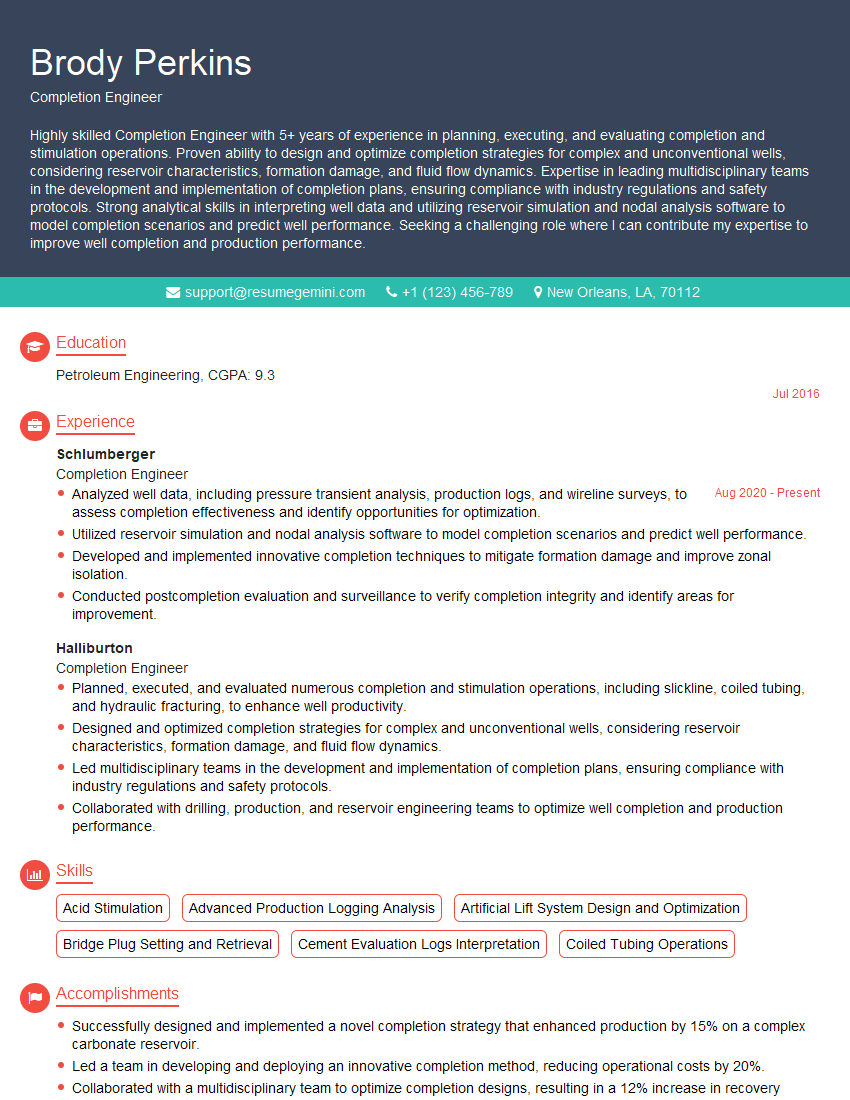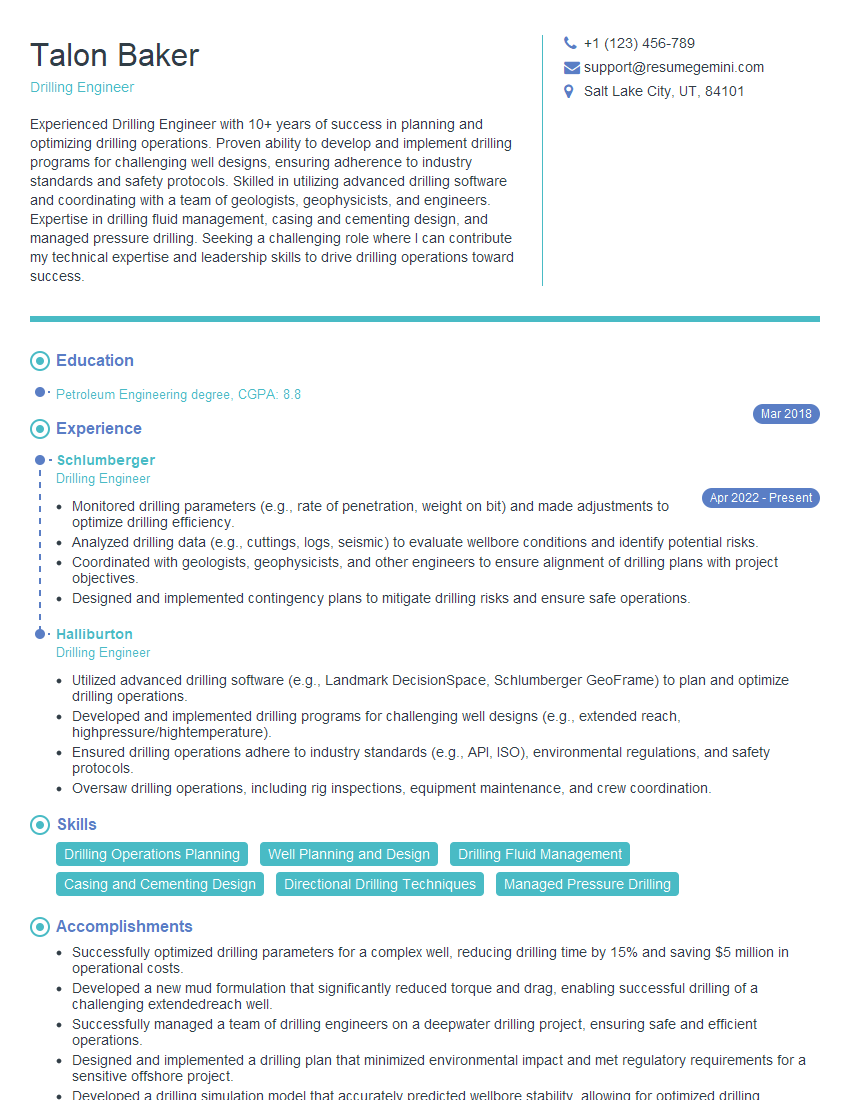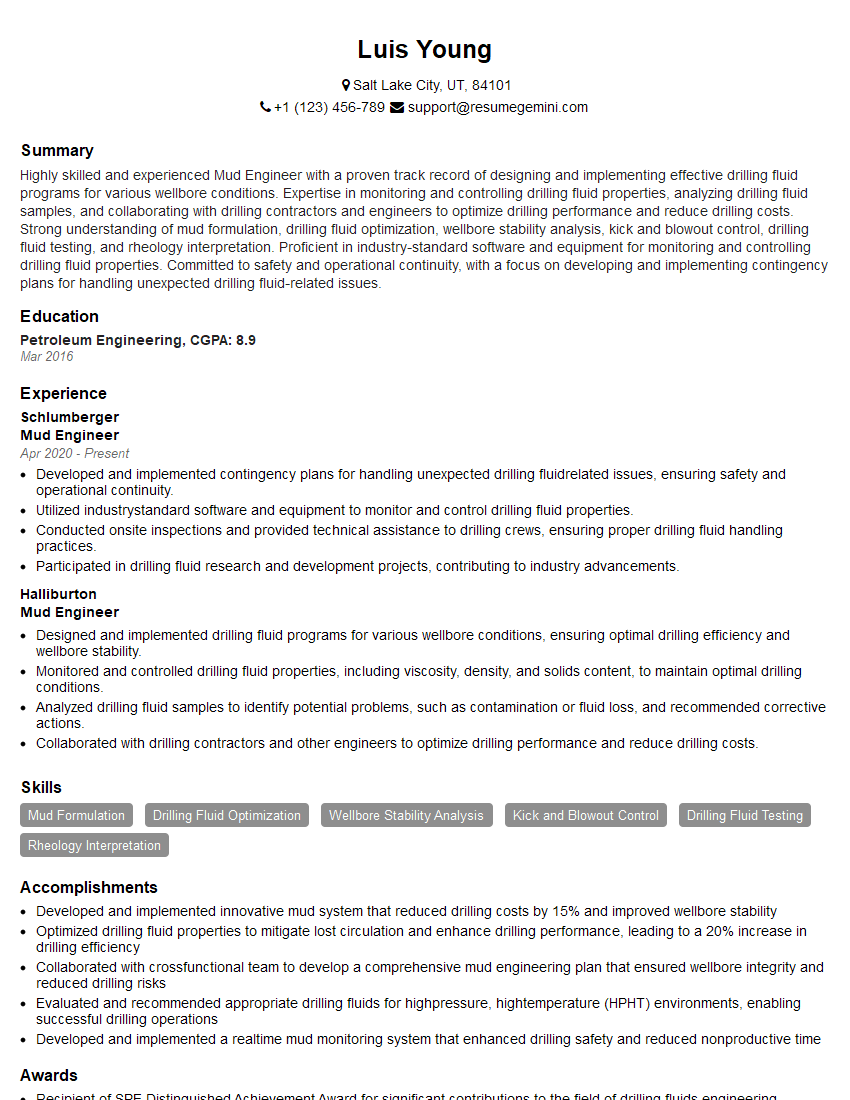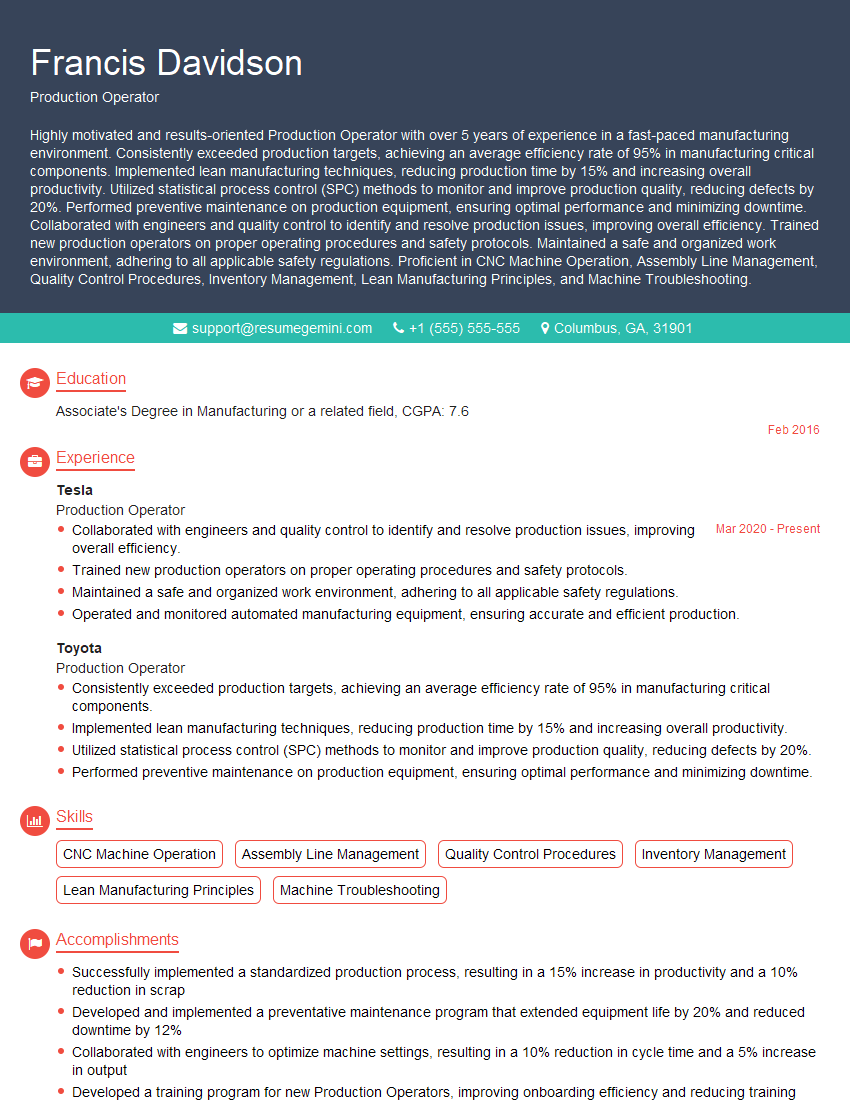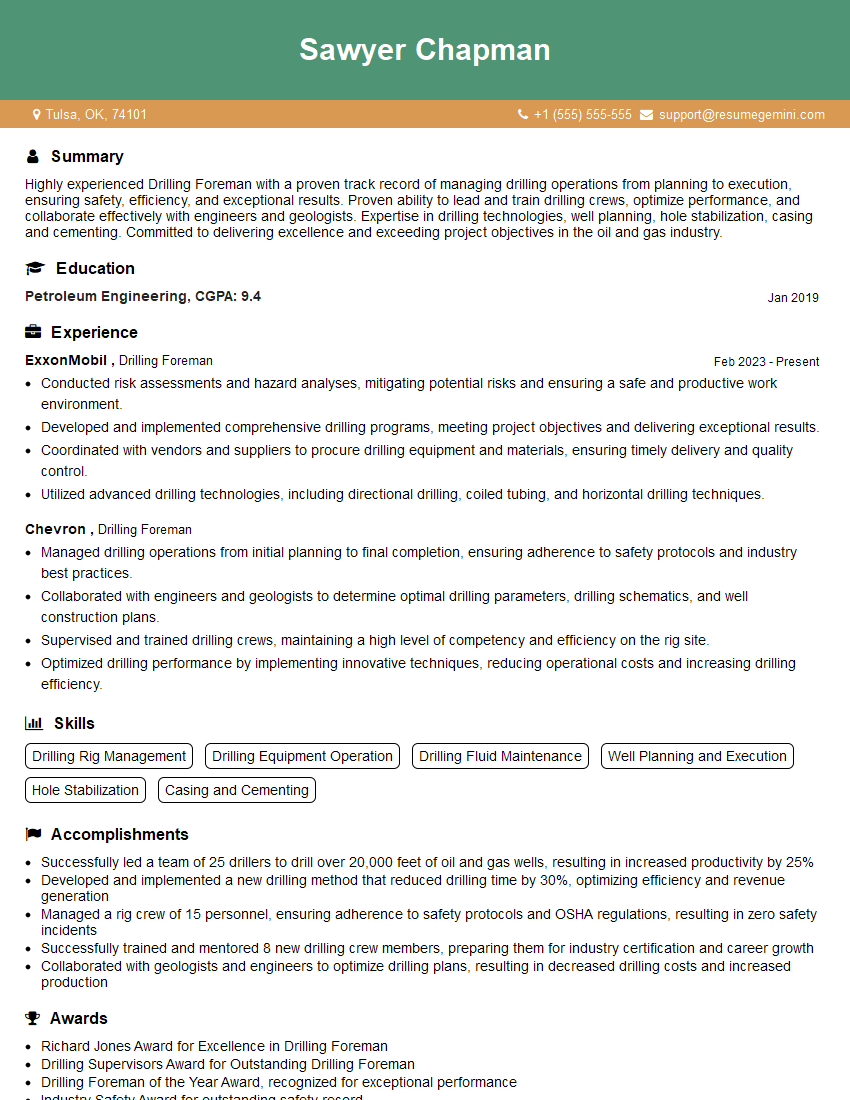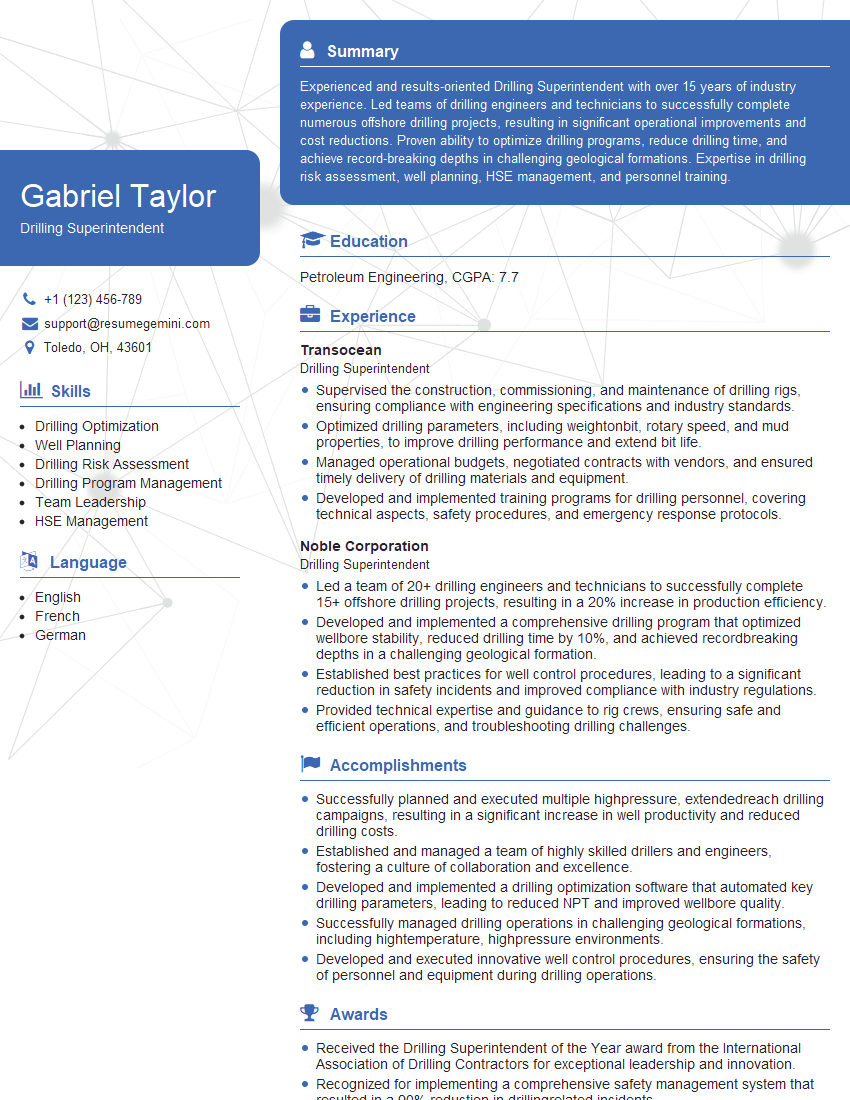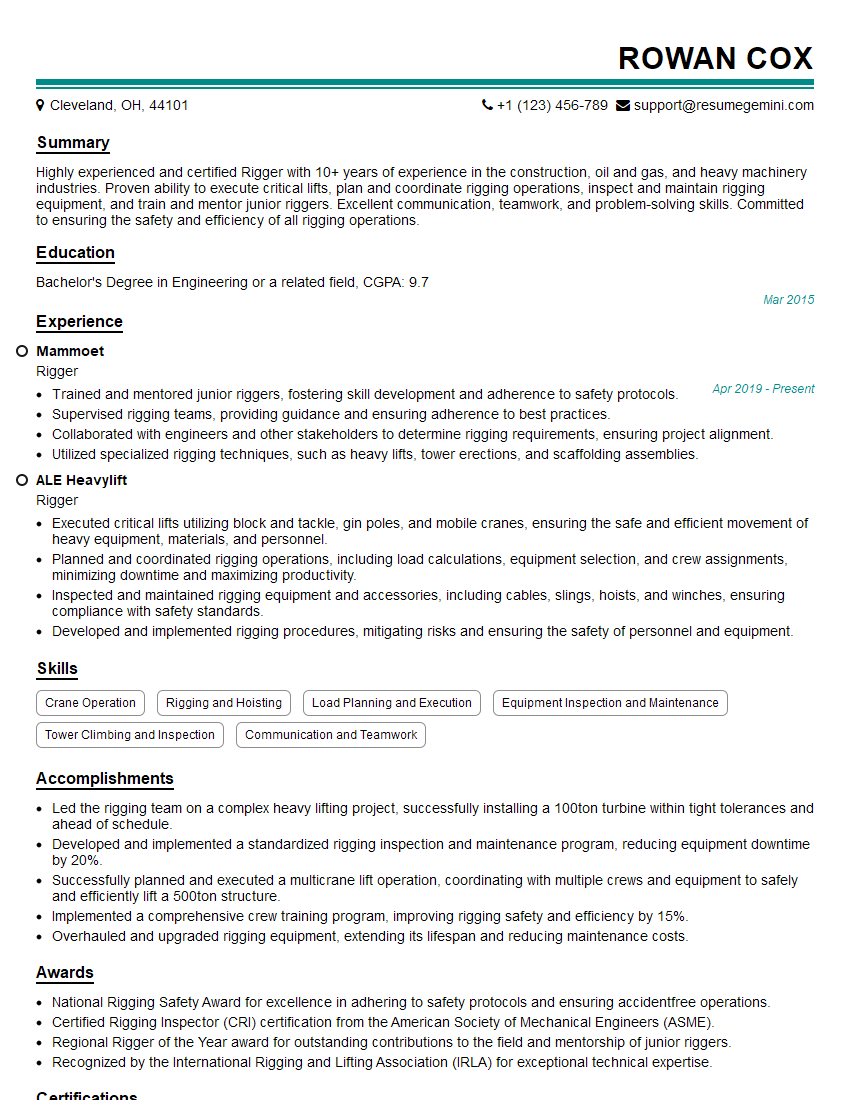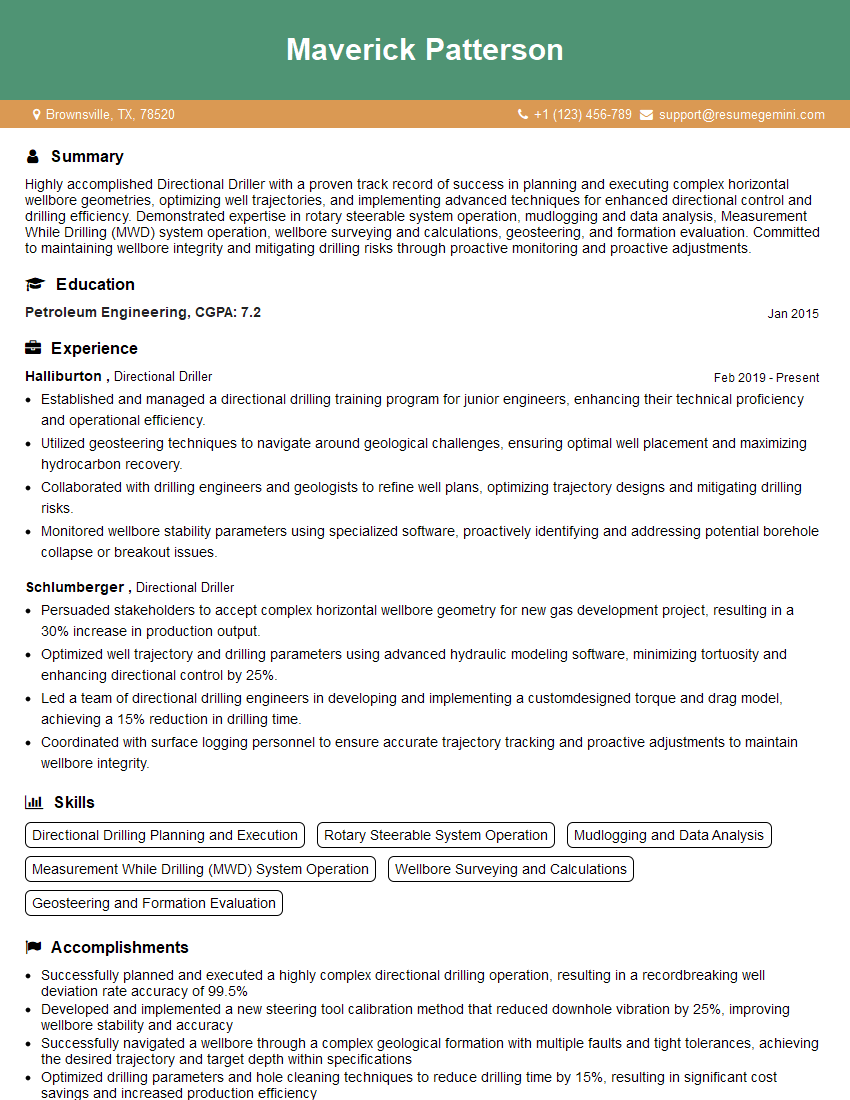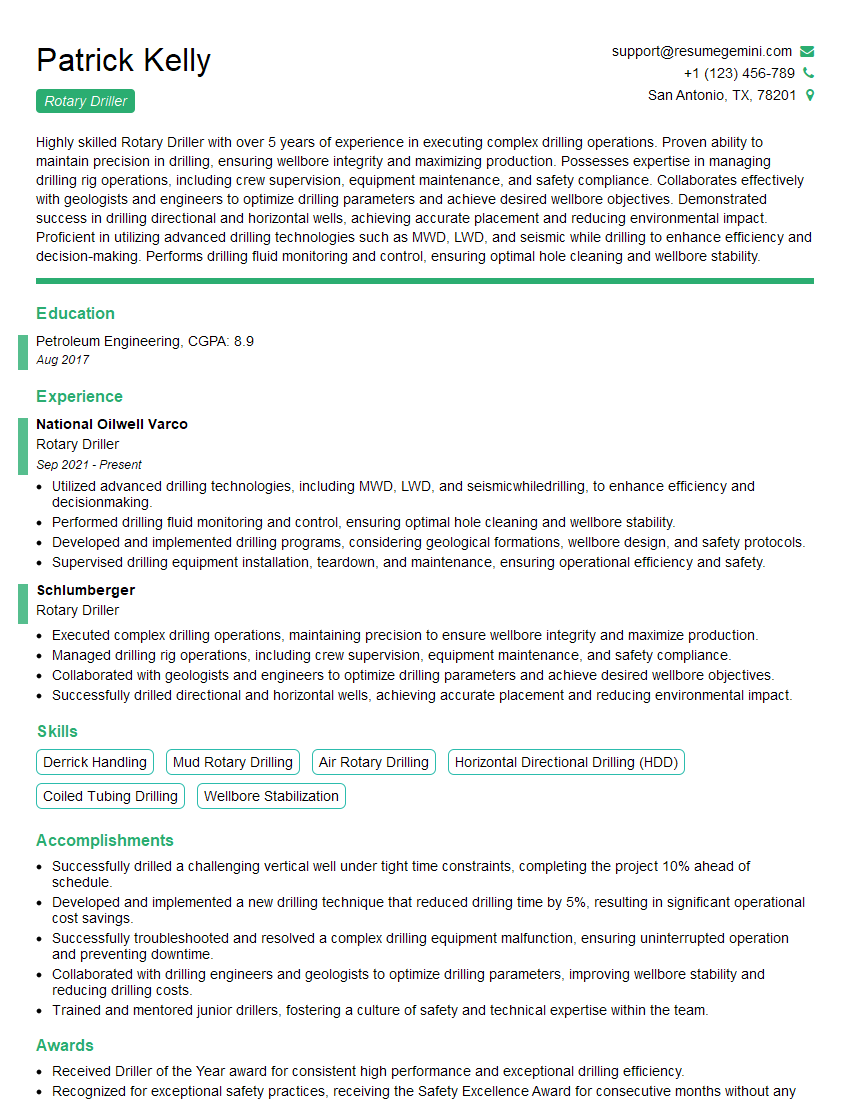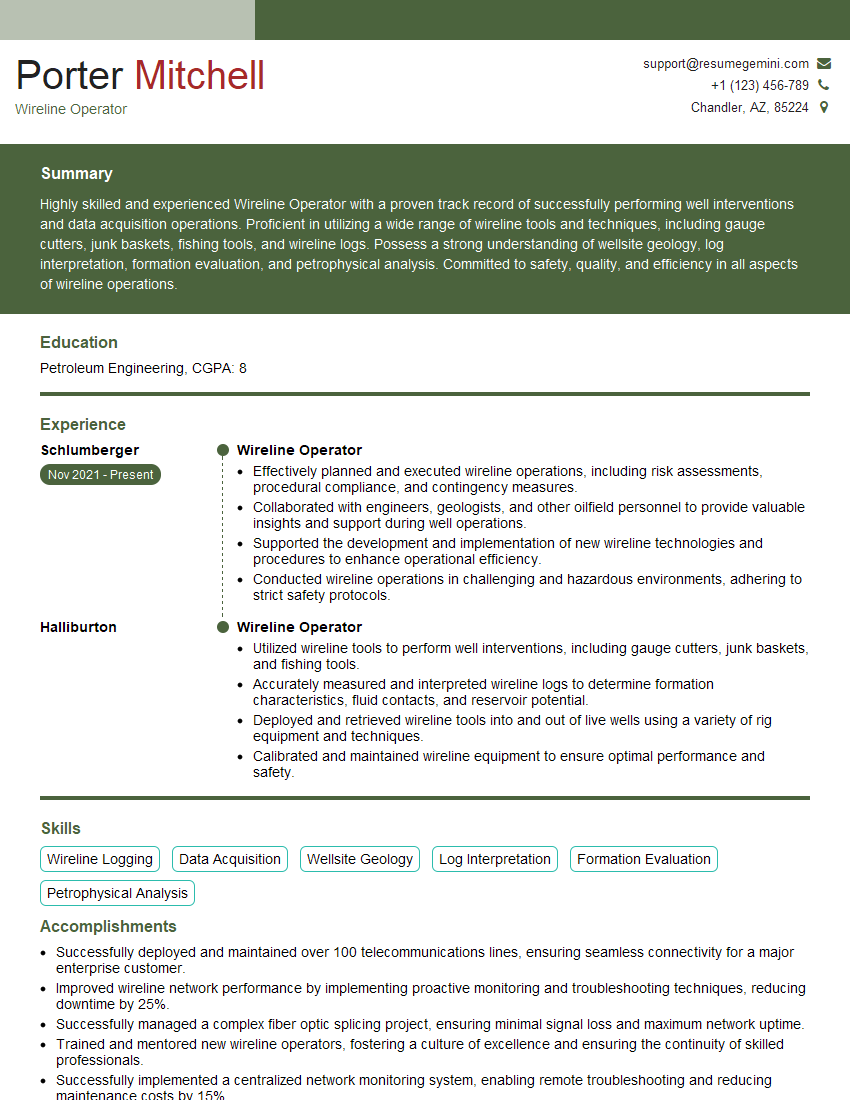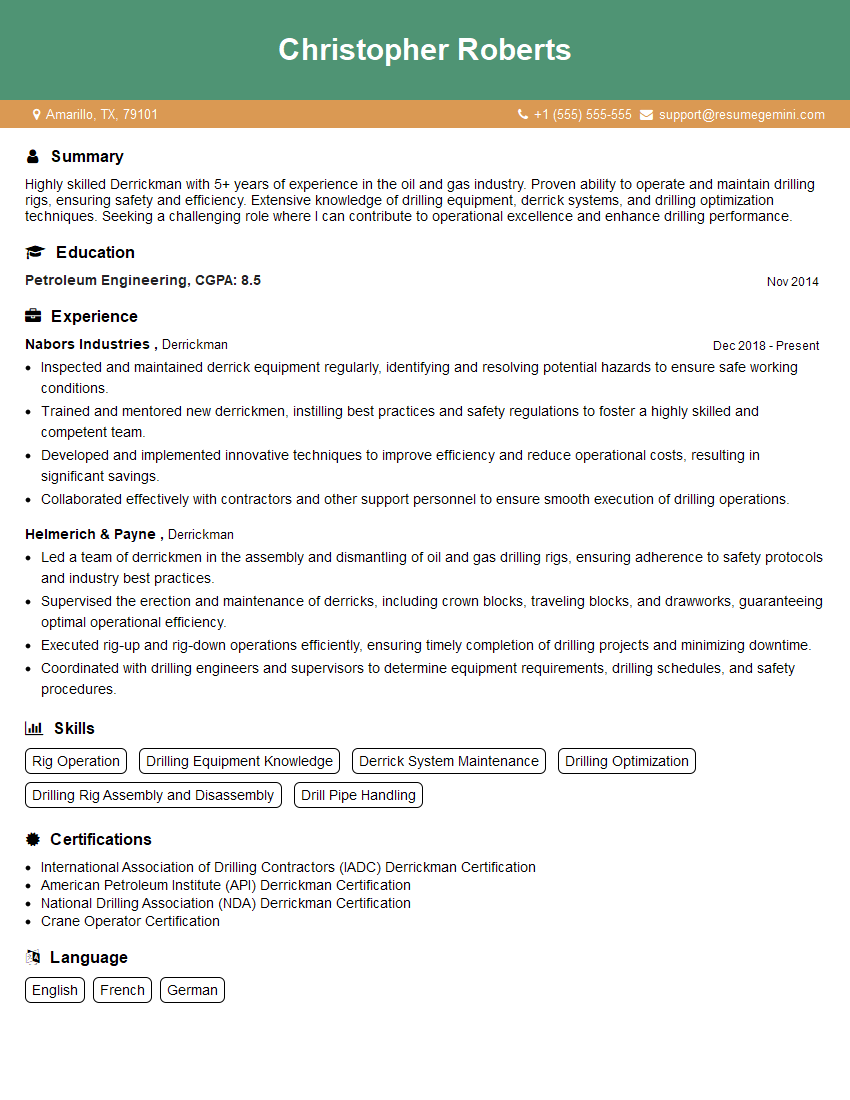Every successful interview starts with knowing what to expect. In this blog, we’ll take you through the top Crew Drill interview questions, breaking them down with expert tips to help you deliver impactful answers. Step into your next interview fully prepared and ready to succeed.
Questions Asked in Crew Drill Interview
Q 1. Describe the different types of drilling rigs.
Drilling rigs are categorized based on their mobility, power source, and the type of drilling they perform. We primarily encounter land-based and offshore rigs. Land-based rigs include:
- Top Drive Rigs: These use a top drive system, a powerful motor mounted on the derrick, to rotate the drill string. They offer superior control and automation. Think of it like having a precise, powerful wrench at the top controlling the drill bit far below.
- Rotary Rigs: These use a rotating table at the bottom of the derrick to turn the drill string. While more traditional, they remain widely used, especially in less complex operations.
- Cable Tool Rigs: These use a cable and bit to lift and drop the drilling tools, primarily for shallow drilling and specific applications. This is like a really heavy-duty hammer striking repeatedly.
Offshore rigs are far more complex and include:
- Jack-up Rigs: These have legs that can be raised and lowered to sit firmly on the seabed. Imagine giant telescopic legs anchoring the rig to the ocean floor.
- Semi-submersible Rigs: These float on pontoons, offering stability even in rough seas. They are remarkably buoyant and stable.
- Drill Ships: These are sophisticated vessels designed for deepwater drilling. They are like floating cities, capable of drilling in extremely challenging environments.
The selection of a rig type depends on the specific project requirements, including water depth, terrain, and drilling complexity.
Q 2. Explain the process of setting up a drilling rig.
Setting up a drilling rig is a meticulous and phased process involving multiple teams and heavy equipment. It begins with site preparation, which includes clearing land, creating access roads, and establishing the location of the rig floor (the area directly beneath the derrick). Next, the rig components are assembled. The derrick is erected – a huge steel structure supporting the drilling equipment – often using a crane. Then, the mud pumps, drawworks (the system that controls hoisting and lowering of the drill string), and other key components are connected and tested. This includes checking all the safety systems. Following this, we have to install the blowout preventer (BOP), a critical safety device located on the wellhead, preventing uncontrolled well flow. Finally, the wellhead, the top portion of the well that connects to the drill string, is installed and cemented. The entire process can take several days, even weeks, depending on the size and type of rig.
Throughout this setup, maintaining stringent safety protocols is paramount; this includes regular inspections, hazard assessments, and adherence to environmental regulations.
Q 3. What are the safety procedures for operating a drilling rig?
Safety is paramount in drilling operations. Our daily routine revolves around several key safety procedures. These include:
- Pre-job safety meetings: Every day starts with briefings discussing potential hazards and control measures. We use a ‘toolbox talk’ format to improve communication and ownership of safety amongst the team.
- Permit-to-work systems: High-risk activities require formal permits, ensuring risk assessment and proper safety measures are in place.
- Emergency response plans: Comprehensive plans and regular drills are essential, preparing the crew to handle well control incidents, fires, or medical emergencies. We conduct regular simulations so that everyone knows their responsibilities, just in case something unexpected happens.
- Personal Protective Equipment (PPE): The mandatory use of hard hats, safety glasses, hearing protection, and other PPE is strictly enforced. Everyone is responsible for their own safety and the safety of their colleagues.
- Regular inspections: Rig equipment is regularly inspected to prevent mechanical failures, and we regularly check emergency shutdown mechanisms and other safety critical equipment to ensure they function correctly.
Failure to adhere to these safety procedures can lead to serious accidents, environmental damage, and substantial financial losses. Safety is not just a set of rules; it’s a mindset ingrained in every member of the crew.
Q 4. How do you manage crew performance and communication?
Managing crew performance and communication on a drilling rig requires a blend of leadership, technical expertise, and effective interpersonal skills. I foster a collaborative environment where everyone feels valued and respected. This involves:
- Clear communication: Regular meetings, shift briefings, and clear communication channels ensure everyone is informed and understands their tasks. We use a combination of face-to-face communication and digital communication tools to maintain constant flow of information, even in busy and demanding situations.
- Performance monitoring and feedback: Regular performance reviews and constructive feedback help identify areas for improvement and recognize excellent work. My goal is to provide support and training to help crew members improve their capabilities.
- Conflict resolution: Effective conflict resolution techniques are essential to maintain a harmonious and productive work environment. I deal with any interpersonal conflicts promptly and fairly, to prevent small issues from escalating.
- Team building: Encouraging team cohesion through social activities and recognition of team achievements improves morale and overall productivity. The high pressure work environment requires the team to operate smoothly, and a strong working relationship is important to maintain efficiency and safety.
Effective crew management significantly impacts drilling efficiency and safety. A well-managed team works more effectively and proactively identifies potential problems, leading to smoother operations.
Q 5. What are the common causes of stuck pipe and how do you troubleshoot them?
Stuck pipe is a major challenge in drilling, significantly impacting time and costs. Several factors can contribute to it:
- Differential sticking: This occurs when the drill string becomes embedded in a permeable formation due to pressure differences between the mud and the formation. Imagine the pipe being ‘sucked’ into the formation.
- Key seating: The drill string becomes wedged against the wellbore. Think of a key jammed in a lock.
- Torque and drag: Excessive torque or drag from friction between the drill string and the wellbore can cause the pipe to become stuck.
- Mechanical failures: Damage to the drill string or wellbore can cause it to become stuck. This could involve a bending of the drill pipe during drilling.
Troubleshooting involves careful analysis of the situation. We would first assess the situation and perform tests before attempting any remediation. If we suspect differential sticking, we would adjust the mud weight. For key seating, we might use jarring techniques to break the pipe free. If severe, specialized equipment or techniques, such as using coiled tubing to help free the pipe might be required. We always prioritize the safest method, considering the risks involved in each operation. The process often involves a careful combination of technical skills, experience, and sound judgment.
Q 6. Explain the importance of mud weight control during drilling.
Mud weight control is crucial for wellbore stability and safety. Mud (drilling fluid) exerts pressure against the wellbore walls, preventing formation fluids from entering the well (a blowout) or causing the wellbore to collapse. The mud weight, measured in pounds per gallon (ppg), needs to be carefully balanced. A mud weight that is too light may lead to a kick (influx of formation fluids), while a mud weight that is too heavy may cause formation fracturing. This could cause the formation to break and collapse, leading to stuck pipe or other problems.
We monitor mud weight continuously using specialized equipment. We adjust the mud weight by adding or removing weighting agents like barite, which are heavy materials that increase the density. Constant monitoring and precise adjustments are vital for maintaining wellbore stability, preventing formation damage, and ensuring safety throughout the drilling operation.
Q 7. Describe your experience with directional drilling techniques.
I have extensive experience in directional drilling, a technique used to drill wells that deviate from vertical. This is particularly crucial in offshore drilling, where wells might need to be drilled horizontally to reach specific reservoir targets or avoid obstacles. Directional drilling utilizes specialized tools like mud motors and steerable downhole assemblies to control the direction and inclination of the wellbore. I’ve worked with various technologies, including rotary steerable systems (RSS) and measurement-while-drilling (MWD) tools, which provide real-time data on the wellbore trajectory. MWD systems are like sophisticated sensors providing information about the location and inclination of the drill bit. This allows us to correct the well path if needed, helping us reach the target with precision.
In one particular project, we used a complex combination of horizontal and vertical drilling techniques to access a remote reservoir target located beneath a major fault line. This demanded precise directional control and meticulous planning to safely and efficiently reach the target. We used advanced modelling software to create the drilling plan, and real-time data monitoring from the MWD system to keep the drilling operation on track. This project highlighted the importance of meticulous planning, expert knowledge, and the use of cutting-edge technology in directional drilling.
Q 8. How do you monitor and maintain the drilling fluid system?
Monitoring and maintaining the drilling fluid system is crucial for efficient and safe drilling operations. It involves continuously monitoring various parameters and taking corrective actions to ensure the mud maintains its optimal properties. Think of the drilling mud as the lifeblood of the well; keeping it healthy is paramount.
Rheological Properties: We regularly check viscosity, yield point, and gel strength using a rheometer. These properties determine how well the mud carries cuttings to the surface and prevents wellbore collapse. For example, if the viscosity is too low, cuttings won’t be effectively removed, leading to potential pipe sticking. Conversely, if it’s too high, it increases pump pressure and could damage the formation.
Fluid Density: Density is monitored using a mud balance and adjusted with weighting materials (like barite) to control wellbore pressure and prevent formation fracturing or kicks (uncontrolled influx of formation fluids). Maintaining the correct density is crucial for wellbore stability.
pH: Regular pH measurement ensures the mud’s chemical balance. An imbalance can lead to corrosion of drilling equipment or unwanted reactions with the formation.
Filtration Control: We monitor the mud’s filtration properties using a filter press to ensure the mud cake forms a proper seal on the wellbore wall, preventing fluid loss and formation damage. A high filtration rate indicates potential issues.
Solids Content: High solids content can increase viscosity and negatively impact the mud’s properties. We monitor and manage solids content through regular shale shaker operations and the addition of chemicals.
Chemical Treatments: We use various chemicals to control the mud’s properties and address specific challenges, such as flocculants to reduce solids content or corrosion inhibitors to protect equipment. The type and quantity of chemicals used are carefully calculated based on the specific formation and drilling conditions.
Maintaining the system involves regular cleaning of equipment like shale shakers and mud tanks, along with proper disposal of waste fluids in compliance with environmental regulations. Proactive maintenance, including regular inspections and timely repairs, is vital to prevent costly downtime and potential safety hazards.
Q 9. What are the key indicators of a wellbore instability?
Wellbore instability is a serious concern in drilling, leading to potential complications like stuck pipe, lost circulation, and even well control issues. Key indicators can be subtle or dramatic, and recognizing them early is crucial.
Increased Torque and Drag: Higher-than-normal torque and drag on the drill string indicate potential wellbore instability, often due to hole collapse or sticking.
Changes in Rate of Penetration (ROP): Unexpected increases or decreases in ROP might suggest changes in formation strength or wellbore condition.
Annular Pressure Changes: Significant fluctuations in annular pressure (pressure between the wellbore and the drill string) can signal formation collapse or fluid loss.
Gas or Fluid Kicks: Sudden increases in mud returns or the presence of unexpected gases suggest formation fracturing or an uncontrolled influx of formation fluids.
Cuttings Analysis: Examination of the cuttings brought to the surface can reveal indications of formation instability, such as sloughing shale or fractured rock fragments.
Logging Data: MWD and LWD tools provide real-time data on wellbore conditions, offering valuable insights into potential instability. For example, imaging tools can show fractures or zones of weakness.
In one instance, I noticed a gradual increase in torque and drag during drilling, even after adjustments to the mud weight. Cuttings analysis revealed highly unstable shale formations. By modifying the mud program to incorporate shale inhibitors and reducing the rate of penetration, we mitigated the issue and prevented a costly stuck pipe incident.
Q 10. What is your experience with well control procedures and equipment?
Well control is paramount in drilling, and my experience encompasses both preventative measures and emergency response. I’m proficient in using various well control equipment, including blowout preventers (BOPs), valves, and choke manifolds.
Preventative Measures: This includes maintaining proper mud weight and rheology, adhering to strict well control procedures, and conducting regular equipment inspections. We conduct regular drills to ensure everyone is proficient in well control procedures.
Emergency Response: My training covers responding to various well control scenarios, including kicks, losses, and well control equipment malfunctions. I’m familiar with procedures such as well shut-in, mud weight increases, and well kill operations. This includes proper handling and use of BOPs and associated equipment.
Well Control Equipment: I have hands-on experience with various BOP stacks, including annular BOPs, ram BOPs, and their associated control systems. I understand the critical importance of regular testing and maintenance of this equipment.
For example, during a drilling operation, we experienced a small kick (influx of formation fluid). Following established well control procedures, we immediately shut in the well, increased mud weight, and circulated the mud to remove the influx. The situation was successfully managed, preventing any serious incident.
Q 11. Explain your knowledge of different types of drill bits and their applications.
Drill bit selection is crucial for optimizing drilling efficiency and minimizing costs. The choice of bit depends on the formation type, anticipated challenges, and the overall drilling plan.
Roller Cone Bits: These bits use rotating cones with teeth or inserts to crush and cut the formation. They are effective in harder formations but have a shorter lifespan compared to other types. They are further categorized into different types based on tooth configuration (e.g., insert bits for hard formations, milled tooth bits for softer formations).
Polycrystalline Diamond Compact (PDC) Bits: These bits use synthetic diamonds embedded in a matrix for cutting. They are highly efficient in softer to moderately hard formations and offer a longer life compared to roller cone bits, particularly in abrasive formations.
Other Specialized Bits: There are also specialized bits designed for specific applications, such as downhole motors for directional drilling or specialized bits for extremely hard formations (e.g., diamond-impregnated bits).
Choosing the correct bit for a given formation is a critical decision. In one project, we encountered a highly abrasive sandstone formation. After evaluating the formation characteristics, we selected PDC bits with a specific diamond configuration designed for abrasive conditions. This selection maximized drilling efficiency and minimized bit wear, resulting in significant cost savings compared to using standard PDC or roller cone bits.
Q 12. How do you handle emergencies and safety incidents on a drilling rig?
Safety is paramount in drilling operations. My approach to handling emergencies and safety incidents is based on a proactive, preventative, and responsive strategy.
Emergency Response Plan: Familiarity and adherence to a comprehensive emergency response plan is crucial. This involves knowing the location of safety equipment, evacuation routes, communication protocols, and the roles and responsibilities of each team member.
Incident Reporting and Investigation: All incidents, regardless of severity, are thoroughly reported and investigated to identify root causes and implement corrective actions to prevent recurrence. Detailed documentation is vital.
Personal Protective Equipment (PPE): Strict enforcement of PPE use is non-negotiable. This includes hard hats, safety glasses, hearing protection, and appropriate clothing.
Emergency Drills and Training: Regular drills and training sessions ensure the team is well-prepared to respond to various emergencies. This includes well control drills, fire drills, and medical emergency response.
Communication: Clear and effective communication between team members is critical during emergencies. Understanding hand signals and radio communication protocols is essential.
In a past incident involving a minor fire on the rig floor, our well-rehearsed emergency response plan allowed us to quickly extinguish the fire with minimal damage and no injuries. The investigation revealed a faulty electrical connection which was subsequently repaired.
Q 13. What is your experience with logging while drilling (LWD) and measurement while drilling (MWD)?
Logging while drilling (LWD) and measurement while drilling (MWD) are essential technologies that provide real-time data from the wellbore during drilling operations. This allows for better decision-making, reducing risks and improving efficiency.
LWD: This involves incorporating sensors and data acquisition systems directly into the drill string, providing data on formation properties such as porosity, permeability, and lithology. This data is transmitted to the surface in real-time, which aids in formation evaluation.
MWD: This focuses on measuring parameters related to the drilling process, such as inclination, azimuth, and torque. This data is crucial for directional drilling and optimizing drilling parameters.
Data Interpretation: Interpreting LWD and MWD data requires specialized knowledge and software. The data helps identify potential zones of interest, optimize drilling parameters, and mitigate potential drilling hazards.
In one project, LWD data revealed a high-porosity zone unexpected from previous seismic data. This information guided our decision to optimize the casing setting point and allowed us to target this potentially productive reservoir more effectively. It also helped identify a problematic shale section that required a specific mud treatment to prevent wellbore instability, averting potential complications.
Q 14. Describe your proficiency in using drilling software and data management systems.
Proficiency in drilling software and data management systems is essential for efficient and safe drilling operations. It allows for better data analysis, reporting, and decision-making.
Drilling Software: I’m experienced in using various drilling software packages for planning, execution, and monitoring of drilling operations. This includes software for well planning, real-time data acquisition, and data analysis.
Data Management: I’m proficient in managing and analyzing large datasets generated during drilling operations. This includes integrating data from various sources (e.g., LWD, MWD, rig sensors), organizing the data into structured databases, and using data visualization techniques for effective communication.
Reporting: I can generate comprehensive reports summarizing drilling performance, wellbore conditions, and other relevant information, which are used to inform decisions and demonstrate operational efficiency.
For example, I utilized drilling software to optimize drilling parameters based on real-time data obtained from MWD tools. By analyzing the data and making informed decisions on weight on bit, rotary speed, and other parameters, we were able to improve ROP and minimize downtime.
Q 15. How do you interpret drilling parameters (ROP, torque, weight on bit)?
Interpreting drilling parameters like Rate of Penetration (ROP), torque, and weight on bit (WOB) is crucial for efficient and safe drilling. It’s like understanding a vehicle’s vital signs – speed, engine load, and braking pressure – to optimize performance and prevent breakdowns.
ROP (Rate of Penetration) indicates how fast the drill bit is penetrating the formation. A high ROP generally signifies efficient drilling, but excessively high ROP can lead to premature bit wear or even stuck pipe. A low ROP might suggest the bit is dull, the formation is harder than anticipated, or there are downhole issues.
Torque measures the rotational force required to turn the drill string. High torque can indicate problems like tight hole conditions, formation sticking, or a worn bit. Low torque, surprisingly, can also be a sign of trouble, indicating insufficient weight on bit or other issues that hinder penetration.
Weight on Bit (WOB) represents the force applied to the drill bit. Optimal WOB is essential for efficient penetration. Too much WOB can lead to premature bit wear, while too little WOB results in slow penetration and potential bit balling.
Example: During a drilling operation, we experienced a sudden drop in ROP accompanied by a significant increase in torque. This suggested we might be encountering a hard formation or experiencing a stuck pipe situation. We carefully reduced the WOB and increased the RPM to help us diagnose and resolve the issue.
Career Expert Tips:
- Ace those interviews! Prepare effectively by reviewing the Top 50 Most Common Interview Questions on ResumeGemini.
- Navigate your job search with confidence! Explore a wide range of Career Tips on ResumeGemini. Learn about common challenges and recommendations to overcome them.
- Craft the perfect resume! Master the Art of Resume Writing with ResumeGemini’s guide. Showcase your unique qualifications and achievements effectively.
- Don’t miss out on holiday savings! Build your dream resume with ResumeGemini’s ATS optimized templates.
Q 16. What are the signs of potential problems with the top drive system?
Potential problems with the top drive system manifest in various ways. It’s like noticing unusual sounds or vibrations in a car’s engine – a warning sign needing attention.
- Unusual Noises: Grinding, squealing, or unusual vibrations from the top drive indicate potential bearing wear, gear problems, or other mechanical issues.
- Reduced Torque Capacity: A decrease in the top drive’s ability to apply torque to the drill string could mean issues with the motor, gearbox, or braking systems.
- Overheating: Elevated temperatures within the top drive point towards lubrication problems, overloaded components, or insufficient cooling.
- Hydraulic Leaks: Leaks in the top drive hydraulic system can result in reduced performance, increased downtime and safety risks.
- Inconsistent Speed: Fluctuations or inability to maintain a set rotational speed usually point to problems within the control system or power supply.
Regular inspections and preventative maintenance are key to avoid these problems. These checks allow us to catch small problems before they escalate into major incidents, saving time and resources.
Q 17. Describe your experience with hydraulic systems on a drilling rig.
My experience with drilling rig hydraulic systems is extensive. I understand the importance of these systems as they are the lifeblood of the rig, powering everything from the mud pumps to the top drive.
I’m proficient in troubleshooting hydraulic systems, identifying leaks, diagnosing pump failures, and understanding accumulator function. I’ve worked with various hydraulic components including valves, pumps, cylinders, and accumulators. This includes preventative maintenance, such as regular fluid sampling and filter changes, and corrective maintenance such as repairing leaks or replacing faulty components.
Example: During one operation, a hydraulic leak in the mud pump system threatened to halt drilling operations. By quickly identifying the leak source, isolating the affected section, and implementing a temporary repair, we managed to minimize downtime and prevent a costly shutdown.
Safety is paramount when working with high-pressure hydraulic systems. I strictly adhere to safety protocols, including lockout/tagout procedures, to prevent accidents during maintenance or repair works.
Q 18. How do you ensure compliance with environmental regulations during drilling operations?
Environmental compliance during drilling operations is not an afterthought; it’s a core principle. We follow all local, regional and national environmental regulations meticulously. This means more than just ticking boxes; it’s a commitment to responsible resource management.
Our methods involve:
- Careful waste management: Proper handling and disposal of drilling muds, cuttings, and other waste products following all regulatory guidelines.
- Minimizing surface spills: Implementing preventive measures and emergency response plans to deal with any accidental spills of fluids.
- Air quality monitoring: Regular monitoring of air emissions to ensure compliance with air quality standards.
- Water management: Efficient use of water resources and minimizing water pollution through the use of environmentally friendly drilling fluids and proper containment practices.
- Proper Permitting and Reporting: Adhering to permitting requirements, maintaining detailed records, and submitting accurate reports to regulatory bodies.
Example: On a previous project, we were required to use specific drilling fluids that minimized the environmental impact on sensitive marine life. We carefully followed the strict procedures for fluid management and disposal to maintain compliance and protect the ecosystem.
Q 19. What are your methods for optimizing drilling efficiency and reducing non-productive time (NPT)?
Optimizing drilling efficiency and reducing NPT (Non-Productive Time) is a constant pursuit. Think of it as aiming for peak performance in any high-stakes operation.
My methods focus on:
- Proactive planning: Thorough pre-job planning, including detailed well design, optimized drilling parameters, and contingency planning to mitigate potential problems.
- Rigorous preventative maintenance: Scheduled and proactive maintenance reduces the chance of unplanned downtime.
- Data-driven decision making: Utilizing real-time data from the drilling process (ROP, torque, WOB etc.) to make informed decisions and adjustments.
- Efficient wellbore planning: Selecting appropriate drilling parameters and bit types based on formation characteristics, this includes choosing the right mud type and weight to prevent issues like wellbore instability.
- Effective communication and teamwork: Clear and constant communication among all crew members ensures smooth operations and quick responses to any issues.
Example: In one project, by analyzing historical data and using advanced drilling models, we were able to predict and avoid potential stuck pipe situations, saving several days of NPT and significantly improving overall efficiency.
Q 20. Describe your experience with different types of drilling fluids and their properties.
Drilling fluids, or muds, are crucial for safe and efficient drilling operations. They’re like the lifeblood of a well, serving multiple functions. Each type has unique properties to tackle various geological formations and drilling challenges.
I have experience with various types including:
- Water-based muds: Cost-effective, environmentally friendly, and suitable for many formations.
- Oil-based muds: Excellent for shale formations and high-pressure, high-temperature (HPHT) wells but have environmental considerations.
- Synthetic-based muds: Offer a balance between performance and environmental considerations; often used in sensitive environments.
The selection of drilling fluid depends on various factors such as formation type, pressure, temperature, and environmental regulations. I understand how different fluid properties, like density, viscosity, and filtration, impact drilling performance, formation stability, and wellbore integrity. Knowledge of fluid chemistry and rheology is also essential for optimizing drilling fluid performance and ensuring effective well control.
Example: When drilling through a highly unstable shale formation, we opted for a synthetic-based mud with specific rheological properties to prevent wellbore collapse and ensure hole stability.
Q 21. How do you manage communication and coordination between different drilling crews?
Effective communication and coordination are paramount in a drilling operation. It’s like a well-orchestrated symphony – every section must play in harmony to produce a beautiful result.
My approach involves:
- Clear roles and responsibilities: Ensuring every crew member understands their role and how it contributes to the overall operation.
- Regular meetings and briefings: Daily or shift-based briefings keep everyone informed about the plan, progress, and any potential challenges.
- Open communication channels: Establishing multiple communication channels to ensure efficient information flow among all crew members, supervisors, and management. This includes radio, phones, and digital platforms.
- Constructive feedback mechanisms: Creating a safe environment for open communication, feedback, and issue resolution.
- Effective reporting: Maintaining detailed reports of all operations, including issues encountered, corrective actions taken, and lessons learned.
Example: In one instance, a potential safety hazard was identified by a member of the floor crew during a regular safety walkthrough. Their immediate report, through established communication channels, allowed for prompt corrective action, averting a potential serious accident.
Q 22. How do you contribute to a positive and safe work environment on the rig?
Contributing to a positive and safe work environment on a drilling rig is paramount. It’s not just about following safety regulations; it’s about fostering a culture of proactive safety. This involves several key strategies.
- Leading by Example: I consistently adhere to all safety protocols and encourage others to do the same. This includes proper use of PPE (Personal Protective Equipment), following lockout/tagout procedures, and actively participating in safety meetings.
- Communication: Open and honest communication is key. I actively participate in toolbox talks, pre-job briefings, and hazard identification processes. I also ensure I communicate clearly and effectively with my crew, reporting any potential hazards immediately.
- Proactive Hazard Identification: I’m trained to spot potential hazards before they become incidents. For example, I regularly check equipment for wear and tear, report any unsafe conditions, and participate in Job Safety Analyses (JSAs) to identify and mitigate risks.
- Teamwork and Support: A safe work environment is a collaborative effort. I support my fellow crew members, offering help when needed and ensuring everyone feels comfortable raising safety concerns without fear of reprisal.
- Following Procedures: Rigorous adherence to company safety manuals and operating procedures is non-negotiable. I make sure everyone on the crew understands and follows these procedures, reinforcing the importance of each step.
For example, during a recent operation, I noticed a loose handrail. I immediately reported it to my supervisor, ensuring it was repaired before anyone could be injured. This proactive approach is crucial to maintaining a safe working environment.
Q 23. What is your experience with pre-job planning and risk assessments?
Pre-job planning and risk assessments are integral to safe and efficient drilling operations. My experience encompasses a thorough understanding of the process, from initial planning to execution.
- Job Safety Analysis (JSA): I’m proficient in conducting JSAs, identifying potential hazards associated with each task, evaluating risks, and implementing control measures. This includes considering factors like wellbore conditions, equipment limitations, and environmental factors.
- Permit-to-Work Systems: I understand and utilize permit-to-work systems, ensuring all necessary authorizations and safety checks are completed before starting any high-risk tasks such as hot work or confined space entry.
- Risk Matrix: I use risk matrices to rank the likelihood and severity of identified hazards, allowing us to prioritize control measures based on their potential impact.
- Emergency Response Planning: I’m involved in developing and practicing emergency response plans, ensuring the crew knows how to respond to various scenarios, such as well control events or equipment malfunctions.
For instance, while planning a complex directional drilling operation, we identified a potential risk of formation instability. Through the JSA, we implemented measures such as slower drilling rates and increased mud weight to mitigate this risk. This pre-planning ensured a safe and successful operation.
Q 24. Describe your experience with different types of casing and cementing operations.
My experience with casing and cementing operations is extensive, covering various types of casing strings and cementing techniques.
- Casing Types: I’m familiar with various casing types, including conductor casing, surface casing, intermediate casing, and production casing, understanding their specific applications and properties. For example, I know when to utilize heavier-weight casing for high-pressure formations or corrosion-resistant casing in aggressive environments.
- Cementing Techniques: My expertise extends to different cementing methods such as displacement, plug and perf, and squeeze cementing. I understand the importance of proper cement slurry design, placement, and evaluation to ensure zonal isolation and well integrity.
- Cement Evaluation: I’m proficient in interpreting cement bond logs (CBL) and variable density logs (VDL) to assess the quality of the cement job, identify potential problems such as channeling or insufficient zonal isolation, and make necessary corrections.
- Troubleshooting: I have experience in troubleshooting cementing problems such as stuck pipe during cementing, channeling, or poor cement displacement.
In one instance, we encountered poor cement bond in the intermediate casing. By analyzing the CBL data, I helped identify a potential problem with the cement slurry design. We adjusted the design for the next casing string, successfully achieving a good cement bond and preventing potential issues.
Q 25. How do you ensure the accuracy and reliability of drilling data?
Ensuring accurate and reliable drilling data is critical for efficient and safe operations. My approach focuses on several key areas.
- Data Acquisition: I use various tools and technologies to acquire drilling data such as mud logs, drilling parameters (ROP, torque, weight on bit), and formation evaluation data.
- Data Validation: I carefully check the acquired data for inconsistencies and errors. This includes comparing data from different sources and identifying any outliers.
- Data Recording and Management: I maintain accurate and organized records of all drilling data, using both digital and paper-based systems, ensuring data integrity and traceability.
- Data Analysis: I analyze drilling data to identify trends, optimize drilling parameters, and predict potential problems. I use this information to make informed decisions that enhance efficiency and safety.
- Calibration and Maintenance: I ensure that all measurement tools are regularly calibrated and maintained to ensure the accuracy of the acquired data. This includes checking sensors, gauges, and other equipment used for data collection.
For example, during a recent well, I noticed a discrepancy between the measured weight on bit and the expected weight. By analyzing the data, I identified a problem with the weight indicator and reported it for calibration. This prevented potential errors in drilling parameters and helped maintain the accuracy of our data.
Q 26. What are your skills in troubleshooting and resolving mechanical issues on a drilling rig?
Troubleshooting and resolving mechanical issues on a drilling rig requires a practical approach and a deep understanding of the equipment. My experience enables me to quickly diagnose and effectively resolve a wide range of problems.
- Systematic Approach: I use a systematic troubleshooting approach. I start by identifying the symptoms of the problem, then investigate potential causes, test my hypotheses, and implement corrective actions.
- Preventive Maintenance: I contribute to preventive maintenance programs by regularly inspecting equipment, identifying potential problems before they become major issues. I also participate in routine maintenance tasks.
- Knowledge of Rig Systems: I have in-depth knowledge of the various systems on a drilling rig, including top drives, mud pumps, drawworks, and hoisting systems.
- Resourcefulness: I’m resourceful in finding solutions, even with limited resources. I can adapt existing parts or improvise solutions when necessary, always prioritizing safety.
- Communication: Effective communication with the crew is crucial during troubleshooting. I clearly explain the problem and the proposed solution to ensure everyone understands and can assist if necessary.
For example, during a drilling operation, the top drive suddenly stopped working. After checking the power supply and hydraulics, I discovered a problem with a faulty sensor. Using my knowledge of the system and available spares, I replaced the sensor, restoring the top drive’s functionality and minimizing downtime.
Q 27. Describe your experience with different types of well completions.
My experience with well completions encompasses a variety of techniques designed to prepare a well for production.
- Completion Types: I’m familiar with various completion methods, including openhole completions, cased-hole completions, and gravel-pack completions, each designed for different reservoir conditions and production requirements.
- Perforating: I understand different perforating techniques and their applications in creating flow paths from the reservoir into the wellbore. This includes shaped charge perforating and various types of guns.
- Stimulation: I’m familiar with well stimulation techniques such as hydraulic fracturing (fracking) and acidizing used to improve reservoir flow and production.
- Artificial Lift: I have knowledge of different artificial lift methods, such as ESPs (Electrical Submersible Pumps), gas lift, and plunger lift, used to enhance production from wells with low reservoir pressure.
- Downhole Tools: I have experience with the use of various downhole tools used during well completion, such as packers, plugs, and screens.
In one project, we used a gravel pack completion to address formation instability and improve production from a sandstone reservoir. This involved careful selection of gravel size and effective placement of the gravel pack, ensuring high production rates without compromising well integrity.
Key Topics to Learn for Crew Drill Interview
- Safety Procedures and Protocols: Understanding and applying safety regulations during crew drills, including emergency response procedures and hazard identification.
- Teamwork and Communication: Demonstrating effective communication skills within a team environment during simulated emergency situations. This includes clear and concise instructions, active listening, and collaborative problem-solving.
- Emergency Response Techniques: Mastering the practical application of emergency response techniques, such as evacuation procedures, fire suppression, and first aid administration, within the context of crew drills.
- Equipment Familiarization: Demonstrating knowledge and practical understanding of relevant safety equipment and its proper usage during drills. This includes understanding limitations and potential hazards.
- Problem-Solving and Decision-Making Under Pressure: Successfully navigating challenging scenarios during drills, showcasing quick thinking, decisive action, and effective problem-solving in high-pressure situations.
- Post-Drill Analysis and Reporting: Understanding the importance of post-drill analysis to identify areas for improvement and contribute to comprehensive reporting on the drill’s effectiveness.
- Regulatory Compliance: Knowing the relevant safety regulations and standards that govern crew drills and demonstrating an understanding of how these regulations apply to practical scenarios.
Next Steps
Mastering Crew Drill demonstrates crucial skills highly valued by employers – teamwork, problem-solving, and a commitment to safety. These skills significantly boost your career prospects across various industries. To maximize your job search success, creating an ATS-friendly resume is essential. ResumeGemini is a trusted resource that can help you build a professional and impactful resume, significantly increasing your chances of landing an interview. Examples of resumes tailored to Crew Drill are available below to guide you.
Explore more articles
Users Rating of Our Blogs
Share Your Experience
We value your feedback! Please rate our content and share your thoughts (optional).
What Readers Say About Our Blog
hello,
Our consultant firm based in the USA and our client are interested in your products.
Could you provide your company brochure and respond from your official email id (if different from the current in use), so i can send you the client’s requirement.
Payment before production.
I await your answer.
Regards,
MrSmith
hello,
Our consultant firm based in the USA and our client are interested in your products.
Could you provide your company brochure and respond from your official email id (if different from the current in use), so i can send you the client’s requirement.
Payment before production.
I await your answer.
Regards,
MrSmith
These apartments are so amazing, posting them online would break the algorithm.
https://bit.ly/Lovely2BedsApartmentHudsonYards
Reach out at [email protected] and let’s get started!
Take a look at this stunning 2-bedroom apartment perfectly situated NYC’s coveted Hudson Yards!
https://bit.ly/Lovely2BedsApartmentHudsonYards
Live Rent Free!
https://bit.ly/LiveRentFREE
Interesting Article, I liked the depth of knowledge you’ve shared.
Helpful, thanks for sharing.
Hi, I represent a social media marketing agency and liked your blog
Hi, I represent an SEO company that specialises in getting you AI citations and higher rankings on Google. I’d like to offer you a 100% free SEO audit for your website. Would you be interested?
